Nancy Moser's Blog, page 6
March 3, 2012
Keep Your Blood Flowing
A little reality check here, my own personal PSA. I was in the hospital this week with blood clots in my leg—and my lungs. I'm recovering at home. I could have died. I'm not out of the woods yet.
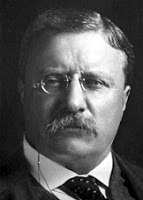 Once I experienced blood clots for myself, I saw references everywhere. Looking through current events and deeper into history, I found a string of people who've suffered from clots—and not survived. Some are famous, and some are ordinary people. Some health issues defy all distinctions of society.
Once I experienced blood clots for myself, I saw references everywhere. Looking through current events and deeper into history, I found a string of people who've suffered from clots—and not survived. Some are famous, and some are ordinary people. Some health issues defy all distinctions of society.
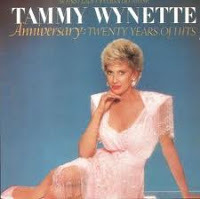 From a young video-gamer who died after getting clots from sitting for 12 hours playing his games, to a young women in England who suspected she had blood clots in her leg, went to a walk-in clinic, was told she had muscle issues and was sent home—to die a few days later.
From a young video-gamer who died after getting clots from sitting for 12 hours playing his games, to a young women in England who suspected she had blood clots in her leg, went to a walk-in clinic, was told she had muscle issues and was sent home—to die a few days later.
NBC correspondent David Bloom died from blood clots after spending days inside a tank while covering the war in Iraq. The rapper Heavy D died after a long international flight. Actress and model Mia Amber Davis died of clots after knee surgery. We lost country singer Tammy Wynette, and former presidents Richard Nixon and Theodore Roosevelt to blood clots--Teddy was only 60.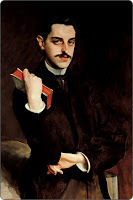
Biltmore builder and philanthropist George W. Vanderbilt was recovering from an appendectomy when he developed fatal blood clots. Just moments before his collapse, he was reading a newspaper and chatting with his wife. He asked her to get him a glass of water and another newspaper. She found him collapsed and he died soon after.
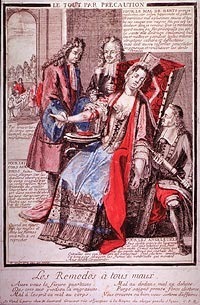 Former vice president Dick Cheney and tennis star Serena Williams survived their clots. Just last month "America's Got Talent" MC (and Mariah Carey's husband) Nick Cannon suffered blood clots to his lungs after being in the hospital.
Former vice president Dick Cheney and tennis star Serena Williams survived their clots. Just last month "America's Got Talent" MC (and Mariah Carey's husband) Nick Cannon suffered blood clots to his lungs after being in the hospital.
Throughout all history, bed-rest has been considered the logical prescription for sickness--and it is. But not for too long. And not without moving our legs about. Who knows how many people throughout history have died from ignorance of this one stipulation? It reminds me of the horrible practice of blood-letting that was thought to cleanse the body of disease, when in fact, it only made the patient weaker.
Each story of blood clots breaks my heart—and honestly, scares me. There but for the grace of God, go I. Go we. Blood clots can happen to any of us. The good news is that we live in the twenty-first century, where we have access to medical care and information.
There are things you can do to lower your chance of blood clots--or DVTs (deep vein thrombosis):
• Blood clots usually start in the lower legs due to inactivity. Long plane rides, car rides, sitting for long hours in one position—anything that impedes blood circularion—can be the cause. When seated for a long time, take breaks and move around every hour. Walk. Flex your ankles. Move your toes, march in place (even while seated). Keep the blood flowing.
• Don't get dehydrated. Drink plenty of water. And remember, alcohol and caffeine dehydrate.
• Blood clots sometimes occur after surgery or hospital stays when other health issues have made you inactive. If you can't get up and walk, move your legs and feet, or if that's not possible, your doctor can put compression sleeves on your legs that are attached to a machine that periodically massages them to keep the circulation going.
• Pregnant women need to be aware--especially if you've had a C-section.
• Obesity adds to the risk
• Your risk can be higher if you take birth control pills or hormone replacement
• Smokers are at higher risk
It's also vital you know the symptoms. With DVTs you may have some or all of these warning signs:
• A touch-sensitive red skin rash
• Pain in the calf, inside of leg, or behind the knee. This can feel like a muscle cramp or a knotty feeling to the veins.
• Red streaks on the leg
• Your skin feels hot to the touch in the affected areas
• Swelling when you stand. This is the most common symptom. When you sit, put your leg up, and straighten it, the pain and swelling may lessen. But as soon as you stand or sit with your knee bent, the leg can swell up to varying degrees, from slightly, to twice its size, even looking like a sausage about to burst. It also might get very red.
What to do if you think you have a blood clot in your leg(s):
• Get to a doctor or to an ER. Depending on the severity, you may be admitted to the hospital and told not to move much or even stand. The danger is that a blood clot can dislodge and travel up the main leg artery to the heart and lungs. This is a pulmonary embolism and can be fatal.
What are the symptoms of a blood clot in your lungs?
• Shortness of breath
• Chest pain
• Rapid heart rate
• Unexplained cough
I'd had a blood clot in my leg for three days and was stupidly waiting for a weekday to go to the doctor—I'm one to avoid the ER if I can. But Sunday morning (again being stupid) I was heading to church, and at the end of my driveway got intense chest pains. My husband drove me to the ER where I had blood clots in my leg, and all three lobes of my right lung! After a few days in the hospital, I'm taking blood thinner now (which doesn't actually thin the blood, but keeps new clots from forming and existing clots from getting bigger.) I'm at home now, waiting for my blood to "thin" to therapeutic levels. There are many good websites full of information. Here's Mayo Clinic's site: BLOOD CLOTS - DVT and WebMD: DVT
 Sorry to go on and on, but with so many of us leading sedentary lives, I want you to be aware. How long are you sitting every day? As a writer I'm at my computer for hours at a time, and do not exercise like I should--though that's going to change after this wake-up call. Add to that our our mobile lives—whether in cars, trains, buses, or planes. We can cross the world in a few hours' time. A good thing--with intrinsic dangers. But knowledge is power. And good health involves being proactive and active. Don't let your personal history end in heartbreak.//Nancy
Sorry to go on and on, but with so many of us leading sedentary lives, I want you to be aware. How long are you sitting every day? As a writer I'm at my computer for hours at a time, and do not exercise like I should--though that's going to change after this wake-up call. Add to that our our mobile lives—whether in cars, trains, buses, or planes. We can cross the world in a few hours' time. A good thing--with intrinsic dangers. But knowledge is power. And good health involves being proactive and active. Don't let your personal history end in heartbreak.//Nancy
 Once I experienced blood clots for myself, I saw references everywhere. Looking through current events and deeper into history, I found a string of people who've suffered from clots—and not survived. Some are famous, and some are ordinary people. Some health issues defy all distinctions of society.
Once I experienced blood clots for myself, I saw references everywhere. Looking through current events and deeper into history, I found a string of people who've suffered from clots—and not survived. Some are famous, and some are ordinary people. Some health issues defy all distinctions of society. From a young video-gamer who died after getting clots from sitting for 12 hours playing his games, to a young women in England who suspected she had blood clots in her leg, went to a walk-in clinic, was told she had muscle issues and was sent home—to die a few days later.
From a young video-gamer who died after getting clots from sitting for 12 hours playing his games, to a young women in England who suspected she had blood clots in her leg, went to a walk-in clinic, was told she had muscle issues and was sent home—to die a few days later. NBC correspondent David Bloom died from blood clots after spending days inside a tank while covering the war in Iraq. The rapper Heavy D died after a long international flight. Actress and model Mia Amber Davis died of clots after knee surgery. We lost country singer Tammy Wynette, and former presidents Richard Nixon and Theodore Roosevelt to blood clots--Teddy was only 60.

Biltmore builder and philanthropist George W. Vanderbilt was recovering from an appendectomy when he developed fatal blood clots. Just moments before his collapse, he was reading a newspaper and chatting with his wife. He asked her to get him a glass of water and another newspaper. She found him collapsed and he died soon after.
 Former vice president Dick Cheney and tennis star Serena Williams survived their clots. Just last month "America's Got Talent" MC (and Mariah Carey's husband) Nick Cannon suffered blood clots to his lungs after being in the hospital.
Former vice president Dick Cheney and tennis star Serena Williams survived their clots. Just last month "America's Got Talent" MC (and Mariah Carey's husband) Nick Cannon suffered blood clots to his lungs after being in the hospital. Throughout all history, bed-rest has been considered the logical prescription for sickness--and it is. But not for too long. And not without moving our legs about. Who knows how many people throughout history have died from ignorance of this one stipulation? It reminds me of the horrible practice of blood-letting that was thought to cleanse the body of disease, when in fact, it only made the patient weaker.
Each story of blood clots breaks my heart—and honestly, scares me. There but for the grace of God, go I. Go we. Blood clots can happen to any of us. The good news is that we live in the twenty-first century, where we have access to medical care and information.
There are things you can do to lower your chance of blood clots--or DVTs (deep vein thrombosis):
• Blood clots usually start in the lower legs due to inactivity. Long plane rides, car rides, sitting for long hours in one position—anything that impedes blood circularion—can be the cause. When seated for a long time, take breaks and move around every hour. Walk. Flex your ankles. Move your toes, march in place (even while seated). Keep the blood flowing.
• Don't get dehydrated. Drink plenty of water. And remember, alcohol and caffeine dehydrate.
• Blood clots sometimes occur after surgery or hospital stays when other health issues have made you inactive. If you can't get up and walk, move your legs and feet, or if that's not possible, your doctor can put compression sleeves on your legs that are attached to a machine that periodically massages them to keep the circulation going.
• Pregnant women need to be aware--especially if you've had a C-section.
• Obesity adds to the risk
• Your risk can be higher if you take birth control pills or hormone replacement
• Smokers are at higher risk
It's also vital you know the symptoms. With DVTs you may have some or all of these warning signs:
• A touch-sensitive red skin rash
• Pain in the calf, inside of leg, or behind the knee. This can feel like a muscle cramp or a knotty feeling to the veins.
• Red streaks on the leg
• Your skin feels hot to the touch in the affected areas
• Swelling when you stand. This is the most common symptom. When you sit, put your leg up, and straighten it, the pain and swelling may lessen. But as soon as you stand or sit with your knee bent, the leg can swell up to varying degrees, from slightly, to twice its size, even looking like a sausage about to burst. It also might get very red.
What to do if you think you have a blood clot in your leg(s):
• Get to a doctor or to an ER. Depending on the severity, you may be admitted to the hospital and told not to move much or even stand. The danger is that a blood clot can dislodge and travel up the main leg artery to the heart and lungs. This is a pulmonary embolism and can be fatal.
What are the symptoms of a blood clot in your lungs?
• Shortness of breath
• Chest pain
• Rapid heart rate
• Unexplained cough
I'd had a blood clot in my leg for three days and was stupidly waiting for a weekday to go to the doctor—I'm one to avoid the ER if I can. But Sunday morning (again being stupid) I was heading to church, and at the end of my driveway got intense chest pains. My husband drove me to the ER where I had blood clots in my leg, and all three lobes of my right lung! After a few days in the hospital, I'm taking blood thinner now (which doesn't actually thin the blood, but keeps new clots from forming and existing clots from getting bigger.) I'm at home now, waiting for my blood to "thin" to therapeutic levels. There are many good websites full of information. Here's Mayo Clinic's site: BLOOD CLOTS - DVT and WebMD: DVT
 Sorry to go on and on, but with so many of us leading sedentary lives, I want you to be aware. How long are you sitting every day? As a writer I'm at my computer for hours at a time, and do not exercise like I should--though that's going to change after this wake-up call. Add to that our our mobile lives—whether in cars, trains, buses, or planes. We can cross the world in a few hours' time. A good thing--with intrinsic dangers. But knowledge is power. And good health involves being proactive and active. Don't let your personal history end in heartbreak.//Nancy
Sorry to go on and on, but with so many of us leading sedentary lives, I want you to be aware. How long are you sitting every day? As a writer I'm at my computer for hours at a time, and do not exercise like I should--though that's going to change after this wake-up call. Add to that our our mobile lives—whether in cars, trains, buses, or planes. We can cross the world in a few hours' time. A good thing--with intrinsic dangers. But knowledge is power. And good health involves being proactive and active. Don't let your personal history end in heartbreak.//Nancy
Published on March 03, 2012 04:00
March 2, 2012
Join me at Writes of Passage today
The lovely ladies at Writes of Passage invited me to drop in today. Hope you can visit me there! www.writespassage.blogspot.com
Published on March 02, 2012 14:08
February 26, 2012
In Honor of Nebraska's African Americans
February is Black History month. I've always been fascinated by ethnic experience different from my own, and so I spent a few minutes gleaning some of Nebraska's African American history for this post. The stories suggested by the facts get this writer's overactive imagination churning.
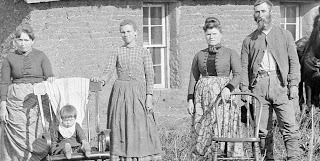 Nebraska City witnessed an auction on December 5, 1860, of "One Negro Man, and one Negro woman, known as Hercules and Martha." The next month the Nebraska Legislature passed an act to abolish slavery in the Territory of Nebraska. But I wonder about Hercules and Martha. According to a booklet published by the Nebraska Writers' Project, "escaped slaves followed the Underground Railroad into Nebraska from Albany, Kansas, continuing through Falls City, Little Nemaha, Camp Creek, and Nebraska City, where the fugitives crossed the Missouri River to Percival, Iowa. From there they were taken to Tabor, Iowa, and outfitted for the balance of their journey into Canada." The booklet mentions a broom-maker who was living in Omaha in 1913 who had escaped slavery via that route. While my history professor reminded me only last week that a very small percentage of slaves ever escaped via the Underground Railroad, one can't help but be drawn to the stories of that desperate journey and the courage it took to attempt it. If I lived in that era, would I have had the courage to help? If I had been a slave, would I have taken the risk? Photographs of pioneer African Americans in Nebraska are relatively few. I look at their faces and I want to hear their voices. What about the young woman pictured above? What was her role in this white family's sod house saga? How did she come to live with them? What about the young man named Moses mentioned in an early census record ... and said to be Native American? Explorers mentioned Africans living among Native Americans very early in western exploration. Their voices are forever silent. What stories would they have told? This family homesteaded in Custer County, Nebraska. A relative remembered hearing the story of her grandfather leading the first black "emigrant train" to Cherry County, Nebraska. He drove one wagon, a son drove another, and a sixteen-year-old girl drove the third. "She took care of her own team and greased the wagon wheels." What a woman!
Nebraska City witnessed an auction on December 5, 1860, of "One Negro Man, and one Negro woman, known as Hercules and Martha." The next month the Nebraska Legislature passed an act to abolish slavery in the Territory of Nebraska. But I wonder about Hercules and Martha. According to a booklet published by the Nebraska Writers' Project, "escaped slaves followed the Underground Railroad into Nebraska from Albany, Kansas, continuing through Falls City, Little Nemaha, Camp Creek, and Nebraska City, where the fugitives crossed the Missouri River to Percival, Iowa. From there they were taken to Tabor, Iowa, and outfitted for the balance of their journey into Canada." The booklet mentions a broom-maker who was living in Omaha in 1913 who had escaped slavery via that route. While my history professor reminded me only last week that a very small percentage of slaves ever escaped via the Underground Railroad, one can't help but be drawn to the stories of that desperate journey and the courage it took to attempt it. If I lived in that era, would I have had the courage to help? If I had been a slave, would I have taken the risk? Photographs of pioneer African Americans in Nebraska are relatively few. I look at their faces and I want to hear their voices. What about the young woman pictured above? What was her role in this white family's sod house saga? How did she come to live with them? What about the young man named Moses mentioned in an early census record ... and said to be Native American? Explorers mentioned Africans living among Native Americans very early in western exploration. Their voices are forever silent. What stories would they have told? This family homesteaded in Custer County, Nebraska. A relative remembered hearing the story of her grandfather leading the first black "emigrant train" to Cherry County, Nebraska. He drove one wagon, a son drove another, and a sixteen-year-old girl drove the third. "She took care of her own team and greased the wagon wheels." What a woman!
A little more is known about Nebraskan Robert Ball Anderson (I couldn't find a photograph). He was born into slavery in Kentucky in 1843. His mother was sold when he was six years old, and he never saw her again. (How does anyone overcome that?) As a young man, he ran away from the plantation and joined the Union Army, serving in the 125th Colored Infantry. After a stint as a Buffalo Soldier in the west, Anderson settled in Butler County and filed on a homestead. A casualty of the grasshopper plague, Anderson moved to Box Butte County. By 1918, he owned over two thousand acres. I often tell people that "what really happened is far more interesting than anything I could make up." Folks are always surprised when I mention that my maternal grandfather was 44 when he married my 22-year-old grandmother (so am I). Mr. Anderson's story is even more unique. In 1922, 79-year-old Robert Anderson married Daisy ... a 22-year-old young woman from Arkansas. Daisy died in 1998 ... a Civil War wife. Think about that for a minute! 1998. A Civil War wife passed away. Speaking of her husband in a recorded interview before she died, Daisy said, "I never had anything in my life. He wanted to make my life better." I couldn't write that novel, because no one would believe it ... but it happened. Would I have survived losing my mother at the age of six in the way Robert Anderson did? Or would I have just given up? Would I have had the courage to run? Would I have regrouped after grasshoppers destroyed my homestead?
Some African Americans today think that a "black history month" is a bad idea. After all, black history is American history. Isn't it just. Courage and perseverance, surviving and succeeding. Here's to their stories.
For more information, see An Illustrated History of African Americans in Nebraska by Bertha W. Calloway and Alonzo N. Smith, Ph.D. Unforgettable stories, compelling photographs.
 Nebraska City witnessed an auction on December 5, 1860, of "One Negro Man, and one Negro woman, known as Hercules and Martha." The next month the Nebraska Legislature passed an act to abolish slavery in the Territory of Nebraska. But I wonder about Hercules and Martha. According to a booklet published by the Nebraska Writers' Project, "escaped slaves followed the Underground Railroad into Nebraska from Albany, Kansas, continuing through Falls City, Little Nemaha, Camp Creek, and Nebraska City, where the fugitives crossed the Missouri River to Percival, Iowa. From there they were taken to Tabor, Iowa, and outfitted for the balance of their journey into Canada." The booklet mentions a broom-maker who was living in Omaha in 1913 who had escaped slavery via that route. While my history professor reminded me only last week that a very small percentage of slaves ever escaped via the Underground Railroad, one can't help but be drawn to the stories of that desperate journey and the courage it took to attempt it. If I lived in that era, would I have had the courage to help? If I had been a slave, would I have taken the risk? Photographs of pioneer African Americans in Nebraska are relatively few. I look at their faces and I want to hear their voices. What about the young woman pictured above? What was her role in this white family's sod house saga? How did she come to live with them? What about the young man named Moses mentioned in an early census record ... and said to be Native American? Explorers mentioned Africans living among Native Americans very early in western exploration. Their voices are forever silent. What stories would they have told? This family homesteaded in Custer County, Nebraska. A relative remembered hearing the story of her grandfather leading the first black "emigrant train" to Cherry County, Nebraska. He drove one wagon, a son drove another, and a sixteen-year-old girl drove the third. "She took care of her own team and greased the wagon wheels." What a woman!
Nebraska City witnessed an auction on December 5, 1860, of "One Negro Man, and one Negro woman, known as Hercules and Martha." The next month the Nebraska Legislature passed an act to abolish slavery in the Territory of Nebraska. But I wonder about Hercules and Martha. According to a booklet published by the Nebraska Writers' Project, "escaped slaves followed the Underground Railroad into Nebraska from Albany, Kansas, continuing through Falls City, Little Nemaha, Camp Creek, and Nebraska City, where the fugitives crossed the Missouri River to Percival, Iowa. From there they were taken to Tabor, Iowa, and outfitted for the balance of their journey into Canada." The booklet mentions a broom-maker who was living in Omaha in 1913 who had escaped slavery via that route. While my history professor reminded me only last week that a very small percentage of slaves ever escaped via the Underground Railroad, one can't help but be drawn to the stories of that desperate journey and the courage it took to attempt it. If I lived in that era, would I have had the courage to help? If I had been a slave, would I have taken the risk? Photographs of pioneer African Americans in Nebraska are relatively few. I look at their faces and I want to hear their voices. What about the young woman pictured above? What was her role in this white family's sod house saga? How did she come to live with them? What about the young man named Moses mentioned in an early census record ... and said to be Native American? Explorers mentioned Africans living among Native Americans very early in western exploration. Their voices are forever silent. What stories would they have told? This family homesteaded in Custer County, Nebraska. A relative remembered hearing the story of her grandfather leading the first black "emigrant train" to Cherry County, Nebraska. He drove one wagon, a son drove another, and a sixteen-year-old girl drove the third. "She took care of her own team and greased the wagon wheels." What a woman!A little more is known about Nebraskan Robert Ball Anderson (I couldn't find a photograph). He was born into slavery in Kentucky in 1843. His mother was sold when he was six years old, and he never saw her again. (How does anyone overcome that?) As a young man, he ran away from the plantation and joined the Union Army, serving in the 125th Colored Infantry. After a stint as a Buffalo Soldier in the west, Anderson settled in Butler County and filed on a homestead. A casualty of the grasshopper plague, Anderson moved to Box Butte County. By 1918, he owned over two thousand acres. I often tell people that "what really happened is far more interesting than anything I could make up." Folks are always surprised when I mention that my maternal grandfather was 44 when he married my 22-year-old grandmother (so am I). Mr. Anderson's story is even more unique. In 1922, 79-year-old Robert Anderson married Daisy ... a 22-year-old young woman from Arkansas. Daisy died in 1998 ... a Civil War wife. Think about that for a minute! 1998. A Civil War wife passed away. Speaking of her husband in a recorded interview before she died, Daisy said, "I never had anything in my life. He wanted to make my life better." I couldn't write that novel, because no one would believe it ... but it happened. Would I have survived losing my mother at the age of six in the way Robert Anderson did? Or would I have just given up? Would I have had the courage to run? Would I have regrouped after grasshoppers destroyed my homestead?
Some African Americans today think that a "black history month" is a bad idea. After all, black history is American history. Isn't it just. Courage and perseverance, surviving and succeeding. Here's to their stories.
For more information, see An Illustrated History of African Americans in Nebraska by Bertha W. Calloway and Alonzo N. Smith, Ph.D. Unforgettable stories, compelling photographs.
Published on February 26, 2012 00:40
February 12, 2012
Valentine's Day
I'm weird, but it's my children's fault. Valentine's Day is about birthdays for me, because my two daughters greeted the world on February 14 and February 15, respectively. Of course the nice thing about that is that the men in their lives can "kill two birds with one stone"--and they shouldn't have a bit of trouble remembering their wife's/girl friend's birthday!
Knowing what you folks already know about me, you won't be surprised that I'm sharing a bit of the women's history behind Valentine's day today. It resonates with me because of some parallels between Esther Howland's life and my own when it comes to entrepreneurship.
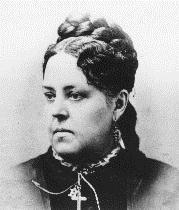
Esther Howland is credited by many with popularizing Valentine's Day in America. Educated at Mount Holyoke Seminary in Massachusetts (class of 1847), Rowland was a "woman with high color and glossy chestnut hair," who "drove high-stepping horses and looked like an aristocrat." She's about fifty in this photo--the only one I could find.
Apparently Esther had both an artistic eye and an entrepreneurial spirit, for when she received an English Valentine (her family operated a large book and stationery store) from one of her father's business associates, she thought she could do better. And so she did. She ordered supplies and made a dozen samples for her brother to take along in his sample book on his next sales trip. Her goal was $200 in orders. Imagine Esther's surprise (and, perhaps, sense of panic), when her brother returned with $5000 in advance sales.
This is where I smiled in reading her story. Back in the 1990s, I decorated a small plush bear and wrote a poem of comfort for a friend. A few bears went into the local Christian bookstore at the owner's request. From there, "Burden Bear" went into a catalog, but only after I convinced the person in charge that yes, I could fill an order for one hundred bears within ten days. Imagine our panic when suddenly the catalog had orders for two thousand bears. And then, a few days later ... two thousand more. Believe me, I can empathize with Esther Howland's feelings when her brother gave her the news of her great success. Success can kill a person!
With the help of some home-schooling Moms who became independent contractors for my bear business, we filled those orders and many more over the next few years--until Thomas Nelson Publishers offered me a book contract. I suppose I was following in the footsteps of women like Esther Howland, who rose to the occasion and created a production assembly line at home--with the help of several female friends. Soon, her cottage industry took over the third floor of the Howland home. Eventually the New England Valentine Company rented a building and even published a small book called The New England Valentine Co.'s Verse Book for 1879.
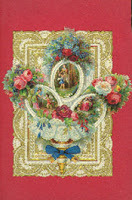 Esther Howland didn't invent the American valentine. She wasn't the first to make them, but she did popularize her own much-admired style. And she stands out to me personally in an era when women weren't expected to found businesses, and when many questioned their mental abilities when it came to such things. In 1881, Howland sold her business to George Whitney, which becames the largest valentine factory in the world.
Esther Howland didn't invent the American valentine. She wasn't the first to make them, but she did popularize her own much-admired style. And she stands out to me personally in an era when women weren't expected to found businesses, and when many questioned their mental abilities when it came to such things. In 1881, Howland sold her business to George Whitney, which becames the largest valentine factory in the world.
See more exquisite examples of Victorian valentines by googling Esther Howland Valentine images.
Here's the little verse I wrote back in 1995 to accompany one of our Valentine's Day gifts.
Love is patient, love is kind,
When somehow wronged, love doesn't mind.
Love bears all things (I like that part)
And patience sets true love apart.
While only God loves perfectly,
His love has flowed through you to me;
I'm grateful for this chance to say
I LOVE YOU--Have a Happy day!
Happy Valentine's Dayfrom Stephanie

Knowing what you folks already know about me, you won't be surprised that I'm sharing a bit of the women's history behind Valentine's day today. It resonates with me because of some parallels between Esther Howland's life and my own when it comes to entrepreneurship.

Esther Howland is credited by many with popularizing Valentine's Day in America. Educated at Mount Holyoke Seminary in Massachusetts (class of 1847), Rowland was a "woman with high color and glossy chestnut hair," who "drove high-stepping horses and looked like an aristocrat." She's about fifty in this photo--the only one I could find.
Apparently Esther had both an artistic eye and an entrepreneurial spirit, for when she received an English Valentine (her family operated a large book and stationery store) from one of her father's business associates, she thought she could do better. And so she did. She ordered supplies and made a dozen samples for her brother to take along in his sample book on his next sales trip. Her goal was $200 in orders. Imagine Esther's surprise (and, perhaps, sense of panic), when her brother returned with $5000 in advance sales.
This is where I smiled in reading her story. Back in the 1990s, I decorated a small plush bear and wrote a poem of comfort for a friend. A few bears went into the local Christian bookstore at the owner's request. From there, "Burden Bear" went into a catalog, but only after I convinced the person in charge that yes, I could fill an order for one hundred bears within ten days. Imagine our panic when suddenly the catalog had orders for two thousand bears. And then, a few days later ... two thousand more. Believe me, I can empathize with Esther Howland's feelings when her brother gave her the news of her great success. Success can kill a person!
With the help of some home-schooling Moms who became independent contractors for my bear business, we filled those orders and many more over the next few years--until Thomas Nelson Publishers offered me a book contract. I suppose I was following in the footsteps of women like Esther Howland, who rose to the occasion and created a production assembly line at home--with the help of several female friends. Soon, her cottage industry took over the third floor of the Howland home. Eventually the New England Valentine Company rented a building and even published a small book called The New England Valentine Co.'s Verse Book for 1879.
 Esther Howland didn't invent the American valentine. She wasn't the first to make them, but she did popularize her own much-admired style. And she stands out to me personally in an era when women weren't expected to found businesses, and when many questioned their mental abilities when it came to such things. In 1881, Howland sold her business to George Whitney, which becames the largest valentine factory in the world.
Esther Howland didn't invent the American valentine. She wasn't the first to make them, but she did popularize her own much-admired style. And she stands out to me personally in an era when women weren't expected to found businesses, and when many questioned their mental abilities when it came to such things. In 1881, Howland sold her business to George Whitney, which becames the largest valentine factory in the world.See more exquisite examples of Victorian valentines by googling Esther Howland Valentine images.
Here's the little verse I wrote back in 1995 to accompany one of our Valentine's Day gifts.
Love is patient, love is kind,
When somehow wronged, love doesn't mind.
Love bears all things (I like that part)
And patience sets true love apart.
While only God loves perfectly,
His love has flowed through you to me;
I'm grateful for this chance to say
I LOVE YOU--Have a Happy day!
Happy Valentine's Dayfrom Stephanie
Published on February 12, 2012 13:11
January 27, 2012
One Simple Act to Save Lives
 Jonathan Rhys Meyer
Jonathan Rhys Meyer
as Henry VIII
in "The Tudors" 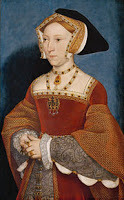 Jane Seymour I was recently watching the mini-series, "The Tudors", and found out that both Henry VIII's mother (Elizabeth of York) and his third wife, Jane Seymour, died of "childbed fever", Jane, after giving birth to Henry's only son, Edward VI. Both women came out of the delivery just fine, but died a short time later. How could a simple fever cause their deaths?
Jane Seymour I was recently watching the mini-series, "The Tudors", and found out that both Henry VIII's mother (Elizabeth of York) and his third wife, Jane Seymour, died of "childbed fever", Jane, after giving birth to Henry's only son, Edward VI. Both women came out of the delivery just fine, but died a short time later. How could a simple fever cause their deaths?
Because it wasn't a simple fever. Childbed fever was a bacterial infection caused by one thing: doctors not washing their hands.
Doctors, who were usually gentlemen, thought their title and status was enough. "Doctors are gentlemen," Charles Meigs of Philadelphia's Jefferson Medical College said, arguing against hand-washing, stating that "gentlemen's hands are clean." But stats and facts obviously said different. In fact, there were far fewer deaths of mothers who had children born at home than those cared for by doctors in hospitals, proving that the doctors habits of not washing their hands between patients created periodic epidemics of childbed fever deaths.
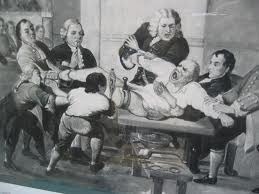 Hospital 1840 In the late 1700's and early 1800's more than one doctor put two and two together and tried to make changes in medical procedures. But to no avail—and often to their own professional downfall. Doctors held themselves above other professions and didn't want to hear that they were at fault, or culpable in anyone's deaths—even though washing hands reduced childbed fever deaths by 90%. Pride goest before destruction, and a haughty spirit before a fall. . . unfortunately, new mothers' destruction.
Hospital 1840 In the late 1700's and early 1800's more than one doctor put two and two together and tried to make changes in medical procedures. But to no avail—and often to their own professional downfall. Doctors held themselves above other professions and didn't want to hear that they were at fault, or culpable in anyone's deaths—even though washing hands reduced childbed fever deaths by 90%. Pride goest before destruction, and a haughty spirit before a fall. . . unfortunately, new mothers' destruction.
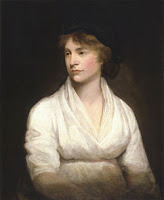 Mary Wollenstonecraft
Mary Wollenstonecraft
There have been other famous women who died of this streptococcus-virus, the same bacteria that causes strep throat (among other ailments.) Eighteenth century feminist, Mary Wollenstonecraft, who wrote A Vindication of the Rights of Woman and who was the mother of the author of Frankenstein , Mary Shelley died of the fever, as did Isabella Beeton—who wrote the well-known Victorian home guide: Mrs Beeton's Book of Household Management . Women's rights and household management... if only these logical-thinking women could have helped the medical profession before it killed them.
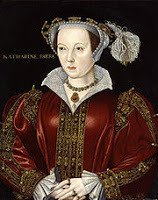 Katherine ParrKatherine Parr, Henry VIII's sixth and last wife, died of the fever after Henry was dead, and she had married her fourth husband, Thomas Seymour—who just happened to be the brother of Jane Seymour, the king's third wife (who, as I said) also died of childbed fever. Interesting interweavings that show the pervasiveness of this type of death.
Katherine ParrKatherine Parr, Henry VIII's sixth and last wife, died of the fever after Henry was dead, and she had married her fourth husband, Thomas Seymour—who just happened to be the brother of Jane Seymour, the king's third wife (who, as I said) also died of childbed fever. Interesting interweavings that show the pervasiveness of this type of death.
A famous person to be born of a mother who contracted the fever--and lived--was the French philosopher, Jean-Jacques Rousseau
Now, sanitary measures have all but eradicated childbed fever, or if contracted, it can be treated with antibiotics. Just another reason to be thankful we live in modern times with soap dispensers at every sink, anti-bacterial sprays and gels, and Wet Wipes.//Nancy
 Jonathan Rhys Meyer
Jonathan Rhys Meyeras Henry VIII
in "The Tudors"
 Jane Seymour I was recently watching the mini-series, "The Tudors", and found out that both Henry VIII's mother (Elizabeth of York) and his third wife, Jane Seymour, died of "childbed fever", Jane, after giving birth to Henry's only son, Edward VI. Both women came out of the delivery just fine, but died a short time later. How could a simple fever cause their deaths?
Jane Seymour I was recently watching the mini-series, "The Tudors", and found out that both Henry VIII's mother (Elizabeth of York) and his third wife, Jane Seymour, died of "childbed fever", Jane, after giving birth to Henry's only son, Edward VI. Both women came out of the delivery just fine, but died a short time later. How could a simple fever cause their deaths?Because it wasn't a simple fever. Childbed fever was a bacterial infection caused by one thing: doctors not washing their hands.
Doctors, who were usually gentlemen, thought their title and status was enough. "Doctors are gentlemen," Charles Meigs of Philadelphia's Jefferson Medical College said, arguing against hand-washing, stating that "gentlemen's hands are clean." But stats and facts obviously said different. In fact, there were far fewer deaths of mothers who had children born at home than those cared for by doctors in hospitals, proving that the doctors habits of not washing their hands between patients created periodic epidemics of childbed fever deaths.
 Hospital 1840 In the late 1700's and early 1800's more than one doctor put two and two together and tried to make changes in medical procedures. But to no avail—and often to their own professional downfall. Doctors held themselves above other professions and didn't want to hear that they were at fault, or culpable in anyone's deaths—even though washing hands reduced childbed fever deaths by 90%. Pride goest before destruction, and a haughty spirit before a fall. . . unfortunately, new mothers' destruction.
Hospital 1840 In the late 1700's and early 1800's more than one doctor put two and two together and tried to make changes in medical procedures. But to no avail—and often to their own professional downfall. Doctors held themselves above other professions and didn't want to hear that they were at fault, or culpable in anyone's deaths—even though washing hands reduced childbed fever deaths by 90%. Pride goest before destruction, and a haughty spirit before a fall. . . unfortunately, new mothers' destruction.
 Mary Wollenstonecraft
Mary WollenstonecraftThere have been other famous women who died of this streptococcus-virus, the same bacteria that causes strep throat (among other ailments.) Eighteenth century feminist, Mary Wollenstonecraft, who wrote A Vindication of the Rights of Woman and who was the mother of the author of Frankenstein , Mary Shelley died of the fever, as did Isabella Beeton—who wrote the well-known Victorian home guide: Mrs Beeton's Book of Household Management . Women's rights and household management... if only these logical-thinking women could have helped the medical profession before it killed them.
 Katherine ParrKatherine Parr, Henry VIII's sixth and last wife, died of the fever after Henry was dead, and she had married her fourth husband, Thomas Seymour—who just happened to be the brother of Jane Seymour, the king's third wife (who, as I said) also died of childbed fever. Interesting interweavings that show the pervasiveness of this type of death.
Katherine ParrKatherine Parr, Henry VIII's sixth and last wife, died of the fever after Henry was dead, and she had married her fourth husband, Thomas Seymour—who just happened to be the brother of Jane Seymour, the king's third wife (who, as I said) also died of childbed fever. Interesting interweavings that show the pervasiveness of this type of death. A famous person to be born of a mother who contracted the fever--and lived--was the French philosopher, Jean-Jacques Rousseau
Now, sanitary measures have all but eradicated childbed fever, or if contracted, it can be treated with antibiotics. Just another reason to be thankful we live in modern times with soap dispensers at every sink, anti-bacterial sprays and gels, and Wet Wipes.//Nancy
Published on January 27, 2012 05:00
January 20, 2012
High School in 1889
I'm reading a history of my home town as part of the research for next year's book, The Shadow of a Name. As I read, I've been creating a timeline of what happened when ... because I don't want to have my main character riding a horse-drawn trolley that didn't exist, or living in a part of the county that was populated only by wolves at the time. Just this evening, I've been adding the growth of the school system to my timeline, and I read something amazing:
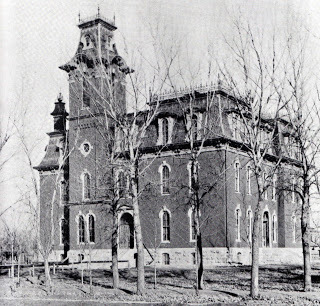 "Thehigh school curriculum comprises four parallel courses of three years each, theEnglish, the Latin, the German, and the Classical. These courses includeinstruction in algebra, book-keeping, geometry, botany, human physiology,physical geography, chemistry, physics, geology, English composition, wordanalysis, technical grammar, orthoepy, elocution, history and development ofEnglish literature, rhetoric, political economy, civil government, elements ofcommercial law, general history, three years each in Latin, Greek, and German.It will be seen that the public schools furnish a good practical education,well rounded out. 9 instructors.
"Thehigh school curriculum comprises four parallel courses of three years each, theEnglish, the Latin, the German, and the Classical. These courses includeinstruction in algebra, book-keeping, geometry, botany, human physiology,physical geography, chemistry, physics, geology, English composition, wordanalysis, technical grammar, orthoepy, elocution, history and development ofEnglish literature, rhetoric, political economy, civil government, elements ofcommercial law, general history, three years each in Latin, Greek, and German.It will be seen that the public schools furnish a good practical education,well rounded out. 9 instructors.
Anotable feature of the high school is a series of lectures on subjects directlyor indirectly connected with the course of study, given by persons prominent ineducational circles, and occurring once or twice per week throughout the year.Among the lecturers have been the Governor of Nebraska, and other Stateofficers, the Chancellor and other members of the faculty of the StateUniversity, lawyers, ministers and physicians of Lincoln, and the instructorsof the high school."
Does that course of study amaze anyone else? I remember my mother, who was born in 1913, saying that elocution was her favorite subject ... in 8th grade. I don't know any 8th graders who would even know what that is. I had to look it up. It's "the study and practice of oral delivery, including the control of both voice and gesture."
And ... orthoepy? a. The study of the pronunciation of words. b. The study of the relationship between the pronunciation of words and their orthography.
Well, now I have to look up orthography. This is getting embarrassing: the art of writing words with the proper letters, according to accepted usage; correct spelling.
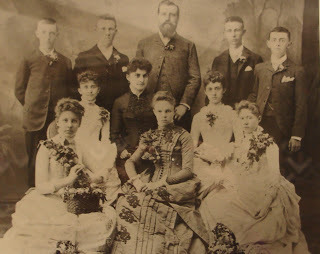 Lincoln's 1889 graduating class was about three times the size of the one pictured at the left. Still, I imagine our graduates dressed much the same. I love the flowers and the general "feel" of the photo, which says to me that they were proud of what they'd accomplished and they were making the day memorable.
Lincoln's 1889 graduating class was about three times the size of the one pictured at the left. Still, I imagine our graduates dressed much the same. I love the flowers and the general "feel" of the photo, which says to me that they were proud of what they'd accomplished and they were making the day memorable.
I wonder how many of those flowers ended up pressed and treasured for years to come. Did any of those young women go on to higher education? What opportunities lay before them? Whatever came their way, I wonder if they used their orthography, orthoepy, and elocution?
As to the high school portrayed above, that is the Lincoln, Nebraska high school, built in 1873. Historian James McKee says that "the trees, it was quickly pointed out, were not for shade or decoration. In the parents' haste to locate the school, they had chosen a site so far to the east of the city that a green belt was needed to protect the building from prairie fires ... Well into the next decade many parents would not allow their children to walk to school in winter for fear that they might be attacked by wild animals."
Honestly, the more I learn about "the good old days," the happier I am that all I do is write about them.
--Stephanie

 "Thehigh school curriculum comprises four parallel courses of three years each, theEnglish, the Latin, the German, and the Classical. These courses includeinstruction in algebra, book-keeping, geometry, botany, human physiology,physical geography, chemistry, physics, geology, English composition, wordanalysis, technical grammar, orthoepy, elocution, history and development ofEnglish literature, rhetoric, political economy, civil government, elements ofcommercial law, general history, three years each in Latin, Greek, and German.It will be seen that the public schools furnish a good practical education,well rounded out. 9 instructors.
"Thehigh school curriculum comprises four parallel courses of three years each, theEnglish, the Latin, the German, and the Classical. These courses includeinstruction in algebra, book-keeping, geometry, botany, human physiology,physical geography, chemistry, physics, geology, English composition, wordanalysis, technical grammar, orthoepy, elocution, history and development ofEnglish literature, rhetoric, political economy, civil government, elements ofcommercial law, general history, three years each in Latin, Greek, and German.It will be seen that the public schools furnish a good practical education,well rounded out. 9 instructors.Anotable feature of the high school is a series of lectures on subjects directlyor indirectly connected with the course of study, given by persons prominent ineducational circles, and occurring once or twice per week throughout the year.Among the lecturers have been the Governor of Nebraska, and other Stateofficers, the Chancellor and other members of the faculty of the StateUniversity, lawyers, ministers and physicians of Lincoln, and the instructorsof the high school."
Does that course of study amaze anyone else? I remember my mother, who was born in 1913, saying that elocution was her favorite subject ... in 8th grade. I don't know any 8th graders who would even know what that is. I had to look it up. It's "the study and practice of oral delivery, including the control of both voice and gesture."
And ... orthoepy? a. The study of the pronunciation of words. b. The study of the relationship between the pronunciation of words and their orthography.
Well, now I have to look up orthography. This is getting embarrassing: the art of writing words with the proper letters, according to accepted usage; correct spelling.
 Lincoln's 1889 graduating class was about three times the size of the one pictured at the left. Still, I imagine our graduates dressed much the same. I love the flowers and the general "feel" of the photo, which says to me that they were proud of what they'd accomplished and they were making the day memorable.
Lincoln's 1889 graduating class was about three times the size of the one pictured at the left. Still, I imagine our graduates dressed much the same. I love the flowers and the general "feel" of the photo, which says to me that they were proud of what they'd accomplished and they were making the day memorable. I wonder how many of those flowers ended up pressed and treasured for years to come. Did any of those young women go on to higher education? What opportunities lay before them? Whatever came their way, I wonder if they used their orthography, orthoepy, and elocution?
As to the high school portrayed above, that is the Lincoln, Nebraska high school, built in 1873. Historian James McKee says that "the trees, it was quickly pointed out, were not for shade or decoration. In the parents' haste to locate the school, they had chosen a site so far to the east of the city that a green belt was needed to protect the building from prairie fires ... Well into the next decade many parents would not allow their children to walk to school in winter for fear that they might be attacked by wild animals."
Honestly, the more I learn about "the good old days," the happier I am that all I do is write about them.
--Stephanie
Published on January 20, 2012 00:13
January 13, 2012
The Ultimate Sacrifice--Arland WIlliams
Ice on the wings.
That's all it took to fell a plane. Today is the 30th anniversary of the crash of Florida Flight 90. Those of you who are over 40 might remember the coverage of the crash on TV. The flight took off in icy conditions, and because of ice of the wings, it couldn't gain altitude. It crashed into the 14th Street bridge in Washington D.C., breaking apart and sinking into the Potomac.
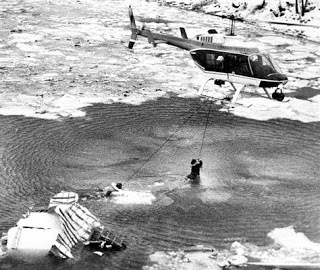 We watched as only six survivors clung to wreckage amid ice floes in the frigid water. Heroes were born that day. And one died… I'll get to him later.
We watched as only six survivors clung to wreckage amid ice floes in the frigid water. Heroes were born that day. And one died… I'll get to him later.
Survivors were saved by heroics from the shore, and one bystander, Lenny Skutnik, flung himself the icy water to pull a woman to safety.
And some were saved by a helicopter rescue. Don Usher, the pilot, hovered precariously over the handful of survivors, while his partner, paramedic Gene Windsor, dropped a life line to the victims in the water. Their bodies nearly frozen, their fingers stiff, they had trouble holding on.
On one occasion, Usher flew so low that one victim was pulled onto the skid of the helicopter. So low that Windsor—standing the on skid to reach her—had his shoes covered with water. Here's a video.
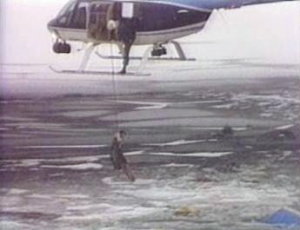 All this happened while we watched on TV. Horrified. Praying. Spellbound.
All this happened while we watched on TV. Horrified. Praying. Spellbound.
And one thing we saw—that has still haunted me these thirty years—was seeing one man repeatedly hand the lifeline to others. Over and over he gave the line away rather than save himself.
And when the others were safe, and the pilot went back for him? He was gone.
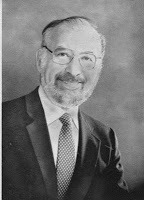 His name was Arland D Williams. He died while offering his fellow passengers--strangers--the greatest sacrifice.
His name was Arland D Williams. He died while offering his fellow passengers--strangers--the greatest sacrifice.
Of the 74 people who died in the plane (and four died on the bridge), all but one died of blunt force trauma.
Only one died of drowning. Arland Williams. Because of that fact, they were able to identify the brave man who gave his life so others might live.
They named the 14th Street bridge the Arland D. Williams Memorial Bridge in his honor.
And yet today, as I read accounts of the crash, few are mentioning him. That is a tragedy. And so I felt compelled to remind the world of his heroism.
Here is a story on Mr. Williams. He also has a Facebook page in his honor. There is an Arland D. Williams Elementary school in Mattoon, Illinois, and the town has a college scholarship fund in his honor. The Citidel, a military school in South Carolina, has an Arland D. Williams Society, "to recognize Citadel graduates who have distinguished themselves through community service, heroism and bravery." He also received many posthumous honors.
That makes me glad. And humbled. One ordinary man who stepped up, who gave up everything . . . I'm an ordinary woman. What would I have done in his situation? What would you do?
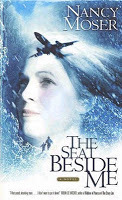 I have always been so moved by this event, and in Mr. Williams sacrifice, that I wrote a book inspired by the crash and the rescue:
The Seat Beside Me
. Although my characters are fictional (in deference to the survivors who are still living) I explored the humanity of the crash. For it all comes down to this: You're sitting in a plane, chatting with your seatmate—who is quite an amazing person. But then the plane crashes. They die and you live. Why them? Why you? How can you live with the burden of being a survivor?
I have always been so moved by this event, and in Mr. Williams sacrifice, that I wrote a book inspired by the crash and the rescue:
The Seat Beside Me
. Although my characters are fictional (in deference to the survivors who are still living) I explored the humanity of the crash. For it all comes down to this: You're sitting in a plane, chatting with your seatmate—who is quite an amazing person. But then the plane crashes. They die and you live. Why them? Why you? How can you live with the burden of being a survivor?
Let me tell you, writing the scenes with my characters in the water, writing the scenes from the hero's point-of-view . . . it was one of the most excruciating and emotional things I've ever done. And because of that, it's the book of my heart. My heart broke a hundred times while writing it...
I wrote it for the heroes of Flight 90, but also for the heros of 9/11, the heroes before and since, the sung and the unsung. I wrote it for the men and women who unexpectedly rise to their greatest while helping others.
But above all, I wrote it for Arland. //Nancy
That's all it took to fell a plane. Today is the 30th anniversary of the crash of Florida Flight 90. Those of you who are over 40 might remember the coverage of the crash on TV. The flight took off in icy conditions, and because of ice of the wings, it couldn't gain altitude. It crashed into the 14th Street bridge in Washington D.C., breaking apart and sinking into the Potomac.
 We watched as only six survivors clung to wreckage amid ice floes in the frigid water. Heroes were born that day. And one died… I'll get to him later.
We watched as only six survivors clung to wreckage amid ice floes in the frigid water. Heroes were born that day. And one died… I'll get to him later.Survivors were saved by heroics from the shore, and one bystander, Lenny Skutnik, flung himself the icy water to pull a woman to safety.
And some were saved by a helicopter rescue. Don Usher, the pilot, hovered precariously over the handful of survivors, while his partner, paramedic Gene Windsor, dropped a life line to the victims in the water. Their bodies nearly frozen, their fingers stiff, they had trouble holding on.
On one occasion, Usher flew so low that one victim was pulled onto the skid of the helicopter. So low that Windsor—standing the on skid to reach her—had his shoes covered with water. Here's a video.
 All this happened while we watched on TV. Horrified. Praying. Spellbound.
All this happened while we watched on TV. Horrified. Praying. Spellbound.And one thing we saw—that has still haunted me these thirty years—was seeing one man repeatedly hand the lifeline to others. Over and over he gave the line away rather than save himself.
And when the others were safe, and the pilot went back for him? He was gone.
 His name was Arland D Williams. He died while offering his fellow passengers--strangers--the greatest sacrifice.
His name was Arland D Williams. He died while offering his fellow passengers--strangers--the greatest sacrifice.Of the 74 people who died in the plane (and four died on the bridge), all but one died of blunt force trauma.
Only one died of drowning. Arland Williams. Because of that fact, they were able to identify the brave man who gave his life so others might live.
They named the 14th Street bridge the Arland D. Williams Memorial Bridge in his honor.
And yet today, as I read accounts of the crash, few are mentioning him. That is a tragedy. And so I felt compelled to remind the world of his heroism.
Here is a story on Mr. Williams. He also has a Facebook page in his honor. There is an Arland D. Williams Elementary school in Mattoon, Illinois, and the town has a college scholarship fund in his honor. The Citidel, a military school in South Carolina, has an Arland D. Williams Society, "to recognize Citadel graduates who have distinguished themselves through community service, heroism and bravery." He also received many posthumous honors.
That makes me glad. And humbled. One ordinary man who stepped up, who gave up everything . . . I'm an ordinary woman. What would I have done in his situation? What would you do?
 I have always been so moved by this event, and in Mr. Williams sacrifice, that I wrote a book inspired by the crash and the rescue:
The Seat Beside Me
. Although my characters are fictional (in deference to the survivors who are still living) I explored the humanity of the crash. For it all comes down to this: You're sitting in a plane, chatting with your seatmate—who is quite an amazing person. But then the plane crashes. They die and you live. Why them? Why you? How can you live with the burden of being a survivor?
I have always been so moved by this event, and in Mr. Williams sacrifice, that I wrote a book inspired by the crash and the rescue:
The Seat Beside Me
. Although my characters are fictional (in deference to the survivors who are still living) I explored the humanity of the crash. For it all comes down to this: You're sitting in a plane, chatting with your seatmate—who is quite an amazing person. But then the plane crashes. They die and you live. Why them? Why you? How can you live with the burden of being a survivor? Let me tell you, writing the scenes with my characters in the water, writing the scenes from the hero's point-of-view . . . it was one of the most excruciating and emotional things I've ever done. And because of that, it's the book of my heart. My heart broke a hundred times while writing it...
I wrote it for the heroes of Flight 90, but also for the heros of 9/11, the heroes before and since, the sung and the unsung. I wrote it for the men and women who unexpectedly rise to their greatest while helping others.
But above all, I wrote it for Arland. //Nancy
Published on January 13, 2012 06:27
December 30, 2011
Welcoming 2012
 My bouquet of GRANDchildren.Do you begin each New Year with a list of resolutions? It seems almost required ... right along with those "the best of" lists that abound regarding the year we've just come through. The more "mature" I become, the less inclined I am to make exhausting lists of things I intend to change in coming months. However, one resolution I know I'll keep regarding my personal life is the one that involves spending more time enjoying the little people pictured to the right.
My bouquet of GRANDchildren.Do you begin each New Year with a list of resolutions? It seems almost required ... right along with those "the best of" lists that abound regarding the year we've just come through. The more "mature" I become, the less inclined I am to make exhausting lists of things I intend to change in coming months. However, one resolution I know I'll keep regarding my personal life is the one that involves spending more time enjoying the little people pictured to the right. When it comes to my writing life, I'm also going to spend more time learning about CRAFT this next year. Other than an English minor in college, a correspondence course in journalism, and a community college class in writing, I'm mostly self-taught when it comes to writing. So in 2012 I'm challenging myself to teach myself more ... a book a month on the nuts and bolts of my job. With the help of some writers I admire, I've compiled a list (given here in alphabetical order by author):
Plot and Structure by James Scott BellCharacters Make Your Story by Maren ElwoodThe Key by James FryPlot Vs. Character by Jeff GerkeHow to Write Best Selling Fiction by Dean KoontzWriting the Breakout Novel by Donald MaasStory by Robert McKeeFiction is Folks by Robert PeckFiction Writing Demystified by Tom SawyerSave the Cat by Blake SnyderStein on Writing by Sol SteinTechniques of the Selling Writer by Dwight SwainThe Writer's Journey by Christopher VoglerThe Moral Premise by Dr. Stanley Williams
If you're counting, that's FOURTEEN titles. We shall see.
In my educational life, this year in May I'll do the walk in the funny hat to receive my Masters' Degree in history. I'll post a photo of the funny hat, and even though I'll turn sixty before graduating, I'm honestly thinking of dancing down that aisle, because this is the fulfillment of a dream I've had since earning my B.A. in 1975. Perhaps there's a message in there ... never give up and you're never too old!
Lest I leave this blog without actually saying something history-related, let me share one of many fascinating things I'm gleaning from David McCullough's book The Greater Journey about Americans in Paris. First, I'm astonished by the number of "great Americans" who spent time studying in Paris. I'm not even half-way through the book, and already I've met Oliver Wendell Holmes, James Fenimore Cooper (did you know he WROTE The Prairie while in Paris?!), Samuel F.B. Morse (did you know he was a painter before inventing the telegraph?), Emma Willard (gotta learn more about her), Elizabeth Blackwell (first female physician in America), William Wells Brown (African-American abolitionist), George Catlin, Ioway Indians, P.T. Barnum, Charles Sumner, and Harriet Beecher Stowe. Goodness! My mind races with amazement and joy as I devour this book.
"Hatty" Stowe, "gazing upward within Notre-Dame, felt a 'sublimity' she found impossible to analyze or express." I relate to that. I've been there and felt that. At the Louvre, Stowe began to compare painters to her favorite writers. A fascinating thought. Rembrandt seemed to her to be like Hawthorne. Here's what she said:
"He [Rembrandt] chooses simple and everyday objects, and so arranges light and shadow as to give them a somber richness and a mysterious gloom. The House of Seven Gables is a succession of Rembrandt pictures done in words instead of oils. Now this pleases us because our life really is a haunted one. The simplest thing in it is a mystery, the invisible world always lies round us like a shadow ..."
I love being challenged to see familiar things in a new light, and McCullough has succeeded in making me do that on nearly every page of this wonderful book. Once again ... the man is my hero as a writer/historian.
For me personally, there is no better place to spend the week approaching a new year than Paris. Since I can't be there in reality this year, I'm grateful for McCullough's taking me there in my imagination ... and combining Paris with history puts two of my favorite subjects in tandem. Let the good times roll!
I wish you each one a blessed New Year. ---Stephanie Grace

Published on December 30, 2011 11:13
December 21, 2011
Seizing the Moments
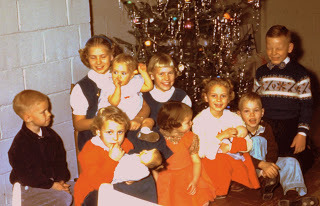 Me and my cousins, 1955. That's me sucking my thumb. At this special time of year I've been thinking back on a bit of personal history, and the issue of time passing too quickly. And what to do about it.
Me and my cousins, 1955. That's me sucking my thumb. At this special time of year I've been thinking back on a bit of personal history, and the issue of time passing too quickly. And what to do about it.
I'd like to say I have the answer to making time slow down, but alas, that bit of quantum physics or science fiction or Divinity escapes me. But I have figured out a way to minimize my regrets.
 My concern about time-passing started a few years ago when I realized I didn't remember my 30's. An entire decade was a blur. Why? Because the years were consumed with the logistics of being married, working, and raising three kids. My days were completely filled with have-to-dos and should-dos and love-to-dos. When I looked to the left then looked to the right, ten years had passed. Whoosh!
My concern about time-passing started a few years ago when I realized I didn't remember my 30's. An entire decade was a blur. Why? Because the years were consumed with the logistics of being married, working, and raising three kids. My days were completely filled with have-to-dos and should-dos and love-to-dos. When I looked to the left then looked to the right, ten years had passed. Whoosh!
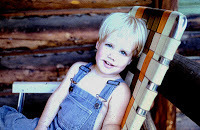 The prime years of my life a blur? That made me incredibly sad. But recognizing this made me stop a moment to think about the happy moments in my life that I did remember vividly. Chaotic Christmases with extended family, the abundance of cookies and laughter filling us up. The family vacations where I packed a Goody-Bag full of small surprises to be doled out to wiggly children when the miles seemed to go on forever. Or waiting backstage for my entrance in a community theatre production of "My Fair Lady", looking up into the dark recesses of the ceiling where catwalks, lights, and scenery lay waiting, thinking about the joy I got from being on stage. These snippets of my life still make me smile and feel warm inside. But they were snippets that couldn't be retrieved because life has gone on.
The prime years of my life a blur? That made me incredibly sad. But recognizing this made me stop a moment to think about the happy moments in my life that I did remember vividly. Chaotic Christmases with extended family, the abundance of cookies and laughter filling us up. The family vacations where I packed a Goody-Bag full of small surprises to be doled out to wiggly children when the miles seemed to go on forever. Or waiting backstage for my entrance in a community theatre production of "My Fair Lady", looking up into the dark recesses of the ceiling where catwalks, lights, and scenery lay waiting, thinking about the joy I got from being on stage. These snippets of my life still make me smile and feel warm inside. But they were snippets that couldn't be retrieved because life has gone on.
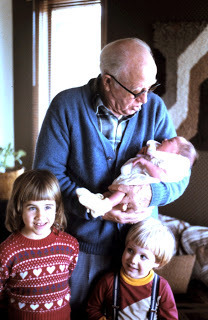 In hindsight I recognized how special these times were--but did I know it at the time? Did I stop and think, I need to appreciate this moment because it's precious?
In hindsight I recognized how special these times were--but did I know it at the time? Did I stop and think, I need to appreciate this moment because it's precious?
Not often enough. And the regret made me ache inside. Why didn't I wallow in those moments? Why was I so busy with today and the next day, that I took those treasured times for granted?
How could I eliminate this regret in the future?
It was a wake-up call. I had to find a way to more fully appreciate the moments of life because now, at age 57, the years are rushing past way too quickly. Ten years from now I do not want to look back on this year and find it a blur.
And so I became determined to have no more regrets—at least not about this. I vowed to enjoy each moment and appreciate it for what it is. To pause just a wee bit and think, This is special. This is good. This is what life is all about. To really see and hear and touch and smell and taste life.
To pause. That's the key. To pause and relish it all.
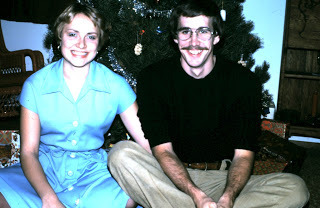 I'm not always successful in remembering "to pause", but I'm getting better at it. For instance, we now have all three kids and their spouses in town and see them and the grandkids often. I do not take that for granted, but fully engage myself in now, and absorb the moments we have together. Like a sponge in water, I soak it all in.
I'm not always successful in remembering "to pause", but I'm getting better at it. For instance, we now have all three kids and their spouses in town and see them and the grandkids often. I do not take that for granted, but fully engage myself in now, and absorb the moments we have together. Like a sponge in water, I soak it all in.
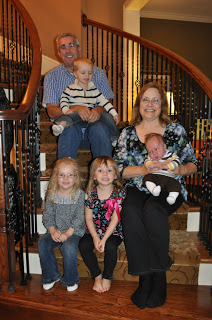 This attempt to appreciate the moment has also made me more defensive of my time. Recently I've dropped two big, weekly obligations that I was involved in for years because I realized where I wanted to be was home. It was a been-there-done-that realization that has given me the gift of time. Free time. When we're younger we feel an obligation to DO. But that's fading for me. I'm content to HAVE DONE things, and move forward with fewer HAVE-TO-DO burdens.
This attempt to appreciate the moment has also made me more defensive of my time. Recently I've dropped two big, weekly obligations that I was involved in for years because I realized where I wanted to be was home. It was a been-there-done-that realization that has given me the gift of time. Free time. When we're younger we feel an obligation to DO. But that's fading for me. I'm content to HAVE DONE things, and move forward with fewer HAVE-TO-DO burdens.
To remind myself to appreciate the here and now, I created a plaque in my house that says, "Now is the most wonderful time of the year." It's displayed every day, through every now, because the truly memorable moments of life aren't always connected to the big celebrations, but to the small moments, the tick and the tock of two seconds that are perfect and splendid because we are simply alive.
 And so dear readers, start giving yourself the gift of NOW. Now. Amid the busyness of life find peace and joy in one fine moment. And then, another. And another. For God is good, and life is a gift to be cherished.
And so dear readers, start giving yourself the gift of NOW. Now. Amid the busyness of life find peace and joy in one fine moment. And then, another. And another. For God is good, and life is a gift to be cherished.
And now is the most wonderful time of the year.
 Me and my cousins, 1955. That's me sucking my thumb. At this special time of year I've been thinking back on a bit of personal history, and the issue of time passing too quickly. And what to do about it.
Me and my cousins, 1955. That's me sucking my thumb. At this special time of year I've been thinking back on a bit of personal history, and the issue of time passing too quickly. And what to do about it.I'd like to say I have the answer to making time slow down, but alas, that bit of quantum physics or science fiction or Divinity escapes me. But I have figured out a way to minimize my regrets.
 My concern about time-passing started a few years ago when I realized I didn't remember my 30's. An entire decade was a blur. Why? Because the years were consumed with the logistics of being married, working, and raising three kids. My days were completely filled with have-to-dos and should-dos and love-to-dos. When I looked to the left then looked to the right, ten years had passed. Whoosh!
My concern about time-passing started a few years ago when I realized I didn't remember my 30's. An entire decade was a blur. Why? Because the years were consumed with the logistics of being married, working, and raising three kids. My days were completely filled with have-to-dos and should-dos and love-to-dos. When I looked to the left then looked to the right, ten years had passed. Whoosh!  The prime years of my life a blur? That made me incredibly sad. But recognizing this made me stop a moment to think about the happy moments in my life that I did remember vividly. Chaotic Christmases with extended family, the abundance of cookies and laughter filling us up. The family vacations where I packed a Goody-Bag full of small surprises to be doled out to wiggly children when the miles seemed to go on forever. Or waiting backstage for my entrance in a community theatre production of "My Fair Lady", looking up into the dark recesses of the ceiling where catwalks, lights, and scenery lay waiting, thinking about the joy I got from being on stage. These snippets of my life still make me smile and feel warm inside. But they were snippets that couldn't be retrieved because life has gone on.
The prime years of my life a blur? That made me incredibly sad. But recognizing this made me stop a moment to think about the happy moments in my life that I did remember vividly. Chaotic Christmases with extended family, the abundance of cookies and laughter filling us up. The family vacations where I packed a Goody-Bag full of small surprises to be doled out to wiggly children when the miles seemed to go on forever. Or waiting backstage for my entrance in a community theatre production of "My Fair Lady", looking up into the dark recesses of the ceiling where catwalks, lights, and scenery lay waiting, thinking about the joy I got from being on stage. These snippets of my life still make me smile and feel warm inside. But they were snippets that couldn't be retrieved because life has gone on.  In hindsight I recognized how special these times were--but did I know it at the time? Did I stop and think, I need to appreciate this moment because it's precious?
In hindsight I recognized how special these times were--but did I know it at the time? Did I stop and think, I need to appreciate this moment because it's precious?Not often enough. And the regret made me ache inside. Why didn't I wallow in those moments? Why was I so busy with today and the next day, that I took those treasured times for granted?
How could I eliminate this regret in the future?
It was a wake-up call. I had to find a way to more fully appreciate the moments of life because now, at age 57, the years are rushing past way too quickly. Ten years from now I do not want to look back on this year and find it a blur.
And so I became determined to have no more regrets—at least not about this. I vowed to enjoy each moment and appreciate it for what it is. To pause just a wee bit and think, This is special. This is good. This is what life is all about. To really see and hear and touch and smell and taste life.
To pause. That's the key. To pause and relish it all.
 I'm not always successful in remembering "to pause", but I'm getting better at it. For instance, we now have all three kids and their spouses in town and see them and the grandkids often. I do not take that for granted, but fully engage myself in now, and absorb the moments we have together. Like a sponge in water, I soak it all in.
I'm not always successful in remembering "to pause", but I'm getting better at it. For instance, we now have all three kids and their spouses in town and see them and the grandkids often. I do not take that for granted, but fully engage myself in now, and absorb the moments we have together. Like a sponge in water, I soak it all in.  This attempt to appreciate the moment has also made me more defensive of my time. Recently I've dropped two big, weekly obligations that I was involved in for years because I realized where I wanted to be was home. It was a been-there-done-that realization that has given me the gift of time. Free time. When we're younger we feel an obligation to DO. But that's fading for me. I'm content to HAVE DONE things, and move forward with fewer HAVE-TO-DO burdens.
This attempt to appreciate the moment has also made me more defensive of my time. Recently I've dropped two big, weekly obligations that I was involved in for years because I realized where I wanted to be was home. It was a been-there-done-that realization that has given me the gift of time. Free time. When we're younger we feel an obligation to DO. But that's fading for me. I'm content to HAVE DONE things, and move forward with fewer HAVE-TO-DO burdens.To remind myself to appreciate the here and now, I created a plaque in my house that says, "Now is the most wonderful time of the year." It's displayed every day, through every now, because the truly memorable moments of life aren't always connected to the big celebrations, but to the small moments, the tick and the tock of two seconds that are perfect and splendid because we are simply alive.
 And so dear readers, start giving yourself the gift of NOW. Now. Amid the busyness of life find peace and joy in one fine moment. And then, another. And another. For God is good, and life is a gift to be cherished.
And so dear readers, start giving yourself the gift of NOW. Now. Amid the busyness of life find peace and joy in one fine moment. And then, another. And another. For God is good, and life is a gift to be cherished. And now is the most wonderful time of the year.
Published on December 21, 2011 11:33
December 15, 2011
A Book Lover's Christmas Tree

This isn't my tree, but I couldn't resist sharing it ... an editor I work for sent me the photo.
Hope the holiday is bringing you joy.
My own Christmas decorations await in the boxes I stored them in last year ... stay tuned! And perhaps I'll even have something to say about Christmas in the 1800s. Sorry I've been away.
Published on December 15, 2011 12:56



